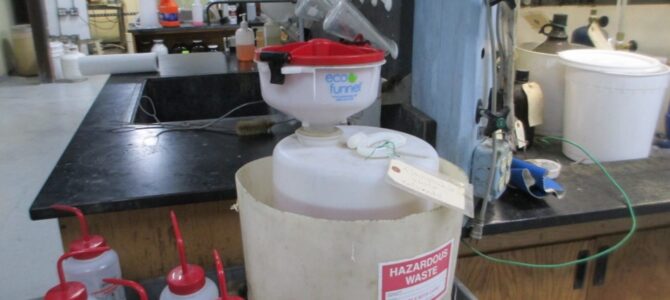The previous regulations for accumulation of hazardous waste in a satellite accumulation area (SAA) and those revised by the Generator Improvements Rule, do not define the term, “under the control of the operator”. In an effort to assist generators to better understand this term and to foster improved compliance with the SAA regulations, USEPA provided examples in the preamble to the proposed rule and requested comments on additional practices that would constitute “under he control of the operator.” These examples were provided in the preamble to the final rule.
The purpose of this article is to provide examples of “under the control of the operator” accepted by USEPA for compliance with satellite accumulation area regulations of 40 CFR 262.15.
Before we begin…
- This is one article in a series that reviews all of the changes made to §262.15 by the Generator Improvements Rule.
- The location of these regulations within Title 40 of the Code of Federal Regulations (CFR) was changed by the Generator Improvements Rule. The satellite accumulation area regulations were located at 40 CFR 262.34(c), they are now found at 40 CFR 262.15.
- FAQ: What is a satellite accumulation area?
- FAQ: What is a central accumulation area?
Scope and Applicability:
- Accumulation of hazardous waste in a SAA is an option for both a large quantity generator of hazardous waste (LQG) and a small quantity generator of hazardous waste (SQG). Very small quantity generators of hazardous waste (VSQG) don’t have to comply with SAA regulations per §262.14(a).
|
Not sure of your hazardous waste generator category? |
- These new regulations were created by the Generator Improvements Rule, which may not yet be adopted by your state. FAQ: What is the status of the Generator Improvements Rule in my state?
- A generator may accumulate either or both of the following in a SAA:
- Acute hazardous waste
- Non-acute hazardous waste (aka: hazardous waste).
40 CFR 262.15(a) reads in part:
…in containers at or near any point of generation where wastes initially accumulate which is under the control of the operator of the process generating the waste,
Note: There were no regulatory changes associated with this action.
What’s it mean?
Examples of “under the control of the operator” provided by USEPA:
- The operator controls access to an area, building, or room in which the SAA is located, such as with entry by access card, key or lock box.
- The operator accumulates waste in a locked cabinet and controls access to the key, even if the cabinet is stored inside a room to which access is not controlled.
Examples provided by commenters and approved by USEPA:
- The Oklahoma Department of Environmental Quality believes that the term “Under the control of the operator” has a much broader meaning than a situation where the operator is regularly within view of the SAA during the course of their job, or a situation where the operator is expected to be able to observe any individuals that may enter or exit the SAA. Though OK DEQ stated its interpretation of “under the control of the operator” is more broad than others, it didn’t specifically state what that interpretation is.
- One state believes as a general rule the SAAs in a manufacturing plant are not in locked cabinets or in locked rooms. They are generally in centralized locations along the assembly lines so all the employees, in several shifts, have access to them. The SAA closest to the assembly line employees would be under their control and be at or near the point of generation. This state does not believe the regulated community would agree to buying several locked cabinets and placing them on the plant floor. It would be very inconvenient for the employees to run and look for the person with the keys to unlock the cabinet every time they need to place waste in the SAA. The sites have controlled access so the entire building would be under control of the operator.”
- The District of Columbia (DC) Department of Energy and Environment suggests that, “under control of the operator” would not include situations where the waste cannot be seen unless the area is equipped with 24 hour video surveillance or 24 hour sensor surveillance. DC also suggests adding criteria such as: the area must be monitored daily by trained personnel and access to the area must be limited to prevent access by untrained personnel or visitors.
|
Contact me with any questions you may have about the generation, identification, management, and disposal of hazardous waste Daniels Training Services, Inc. 815.821.1550 |
- One commenter referenced an EPA memo (RO 11728) that discussed the term “under control of the operator.” In that memo EPA states: “The condition that wastes accumulated under the satellite provision `be under control of the operator of the process generating the waste’ is met provided the generator demonstrates that the personnel responsible for generating/or accumulating the waste have adequate control over the temporary storage of these wastes. The EPA recognizes that for many wastes, the person who first generates the waste may not be the same person responsible for the accumulation of all of these wastes; rather, another worker may have responsibility of overseeing the temporary storage of wastes.”
Note: This is not an all-inclusive or exhaustive list of practices that may be used to meet the requirement for hazardous waste in a SAA to be “under the control of the operator.”
Read: FAQ: Must the “operator” of a satellite accumulation area be a single individual?
Conclusion:
USEPA’s intent using the term “under the control of the operator” is to ensure that someone familiar with the operations generating the hazardous waste is aware of an able to attend to the operations, if needed, while also providing some measure of controlled access.
|
Contact me the next time hazardous waste generator USEPA training is due to expire. |
